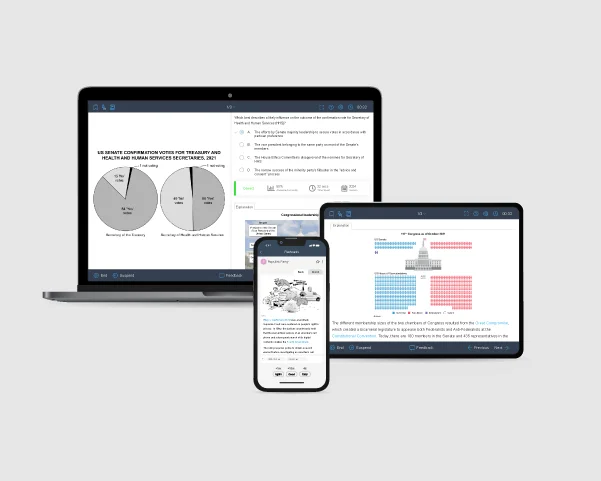How Is the AP U.S. Government and Politics Exam Scored?
The AP U.S. Government exam is made up of two sections. As you may already know, Section I contains multiple-choice questions (MCQs), and Section II consists of free-response questions (FRQs). The MCQ section includes 55 questions, and the FRQ section has four questions. One of the four FRQs is an argument essay. As of 2024, the total composite score for the AP U.S. Gov exam is 120, with each section carrying 50% of the total exam weight. The table below explains the number of questions and the composite score for each section:
| Section | No. of Questions | Raw Score |
|---|---|---|
| Section I | 55 MCQs | 60 |
| Section II | 4 FRQs | 60 |
| Subtotal | 120 | |
Section I: Multiple-Choice Section (MCQ)
The total Section I raw score for the 2024 AP U.S. Gov exam was 60 points, with each correct answer carrying roughly 1.09 points. Your total AP Gov score, therefore, is calculated by multiplying the number of correct answers by 1.09.
Are you penalized for guessing on the AP U.S. Government & Politics exam? No!
Because you are not penalized for wrong answers, attempt to answer every question, even if you have to guess. That will give you at least a 25% chance of answering a question correctly and add more points to your composite score.
Section II: Free-response section (FRQ)
In Section II, the scoring of the FRQ questions is a bit more complex. Each question is graded separately according to the criteria on the College Board®'s scoring rubric. Once all the FRQs are graded with the rubric, the scores are added together, resulting in a total score out of 60 possible points for Section II.
The scores from Section I and Section II are then combined to get your overall score out of 120 points. Finally, this composite score is converted to a number on the AP scale, which ranges from 1 to 5.
As of 2019, the College Board has discontinued releasing the AP Government scoring worksheet. The table and calculations may or may not apply to the upcoming AP U.S. Gov exam scoring criteria.
AP U.S. Government and Politics Scoring Guidelines and Rubrics
Remember the scoring guidelines and rubrics we discussed earlier? Well, every year, the College Board publishes a document that helps students and teachers understand how points are allotted to each FRQ answer.
These scoring guidelines and rubrics can help you learn what kinds of answers can earn you points and what skills you need to focus on while addressing the FRQs.
You will earn points if your answer fulfills any or all of the following criteria, depending on the question's intent:
- Identify a clause, fact, excerpt, evidence, or context of the prompt.
- Describe and/or explain relevant facts and information pertaining to the question.
- State a claim in response to the prompt and support it based on evidence, documentation, data, and facts.
- Explain why a piece of evidence supports the claim or thesis.
The table below shows the number of points per FRQ for the 2021 and 2022 AP Gov exams. You can use the rubric to get a rough idea of how the FRQs are graded and apply it while practicing for your exam:
| Section II | Task Verbs | Points | Total Points |
|---|---|---|---|
| FRQ 1 Concept Application |
Part A : Describe a concept, event or action | 1 | 3 |
| Part B : Explain (how or why) an idea/event in that specific concept | 1 | ||
| Part C : Explain (how or why) an idea/event in that specific concept | 1 | ||
| FRQ 2 Quantitative Analysis |
Part A : Identify a characteristic or pattern in an event or an action | 1 | 4 |
| Part B : Describe the characteristic or pattern in the event or action | 1 | ||
| Part C : Explain why or how that specific event or action occurred | 1 | ||
| Part D : Explain the validity or impact of the data provided | 1 | ||
| FRQ 3 SCOTUS Comparison |
Part A : Identify a specific clause or amendment established by the SCOTUS | 1 | 4 |
| Part B : Describe relevant fact(s) from the case(s) in the prompt ORCompare the cases and explain the similarities/differences in reasoning of the decision(s) |
1 OR 2 |
||
| Part C : Explain how that decision can impact other case(s) | 1 | ||
| FRQ 4 Argument Essay |
Row A : State and explain a defensible claim or thesis in response to the prompt | 1 | 6 |
| Row B : Use pieces of evidence to support the claim | 3 | ||
| Row C : Explain how or why the evidence supports the claim or thesis | 1 | ||
| Row D : Describe an alternate perspective and refute, concede, or rebut that perspective | 1 |
Usually, a question has multiple parts, with each part containing a specific prompt. Typically, one prompt earns one point. However, in cases where you need to present various pieces of evidence or facts to support your claim, more than one point may be awarded depending on the number of examples or evidence you cite. This is most commonly the case with Part (b) of the SCOTUS FRQ, where you receive one point for identifying or describing a relevant detail about a ruling/opinion from a required case and then another point for using that detail to compare or contrast the required case with the non-required case.
Looking to excel on the exam? Explore UWorld’s AP U.S. Government course and take your preparation to the next level.

AP U.S. Government and Politics Scoring Table
Your AP U.S. Government exam results are forwarded to the universities you have chosen for admission after being recorded on the AP grading system. Check out our page on AP Exam Scores if you want to learn how to send your AP U.S. Government scores directly to your college.
While each college may have its own requirements for admission based on AP scores, most colleges use a standard method to translate your AP U.S. Gov score into the corresponding college grade. The AP score table below shows the conversion of AP U.S. Government scores into equivalent college grades:
| AP Exam Score | College Grade Equivalent | Qualification |
|---|---|---|
| 5 | A+ or | Extremely well qualified |
| 4 | A-, B+, or B | Very well qualified |
| 3 | B-, C+, or C | Qualified |
| 2 | — | Possibly Qualified |
| 1 | — | No recommendation |
As you can see, colleges do not consider scores below 3 during admissions. The rule of thumb is to achieve a score of 3 or higher if your goal is to earn college credit for your AP Gov exam score. Make it a point, however, to still check the minimum AP course credit requirements for each of your potential colleges.
AP U.S. Government and Politics Score Distributions
AP Gov is among the most popular AP exams students take each year. This is because U.S. Gov is one of those versatile subjects that students like to pair with other similar AP courses like U.S. History, World History, and Comparative Government and Politics. In addition to complementing these subjects, scoring well in U.S. Gov can potentially earn college credits and fulfill graduation criteria. Another benefit of taking the AP U.S. Government and Politics exam is that it can amp up your career game.
If you are preparing for the exam, it is recommended that you look at past years' AP Gov score distributions to get an idea of how rigorous this course can be. This can also help you see if you are ready to add this heavy-weight course to your schedule, especially if you have already signed up for other AP courses. Let’s crunch some numbers below to get an idea of how students performed on the AP U.S. Gov exam during the last four years:
| AP Score | % of Students 2024 | % of Students 2023 | % of Students 2022 | % of Students 2021 |
|---|---|---|---|---|
| 5 | 24.3% | 13% | 12.1% | 12.0% |
| 4 | 25.0% | 11% | 10.9% | 11.6% |
| 3 | 23.7% | 25% | 25.9% | 26.9% |
| 2 | 18.1% | 24% | 25.7% | 25.8% |
| 1 | 8.9% | 27% | 25.4% | 23.8% |
| 3 or Above | 73.0% | 49% | 48.9% | 50.5% |
Earning a score of 3 or higher on the AP U.S. Government exam has traditionally been difficult for students. In 2022, just 48.7% reached this mark, with a modest increase to 49.2% in 2023. However, the 2024 exam saw a remarkable improvement, with 73% of students achieving a score of 3 or above.
At Uworld, we believe that reviewing the course material regularly and taking frequent practice tests will help you form a solid foundation of core concepts. If you need help, check out our AP U.S. Gov QBank with detailed answer explanations, quick notes, and flashcards to retain concepts efficiently.
Scoring pattern for the 2024 and 2023 AP U.S. Government and Politics exams
While knowing the AP Gov score distributions can give you an idea of your probability of success on it. Additionally, try to be aware of the test’s scoring pattern to understand how students have historically performed in various sections of the exam. It will help you gauge which sections are the most difficult and which sections are the easiest.
On the 2024 AP Gov exam, students’ performance on the AP US Government multiple-choice section was outstanding, especially on data analysis questions and Unit 5 (Political Participation). The majority of students answered most or all of these questions correctly, demonstrating a strong grasp of the material.
Students scored highest on the SCOTUS comparison (Q3) in the AP US Government FR section and found Q1 the most challenging.
On the 2023 exam, students demonstrated their impressive aptitude for knowledge in the MCQ section, especially with regard to SCOTUS cases. About 36% of students earned all the possible points in this section–impressive!
Students also excelled in their understanding of course content, with 24% answering all Unit 3: Civil Liberties & Civil Rights questions correctly–a remarkable achievement.
The highest overall FRQ performance was on Q2 - Quantitative Analysis. Students seemed to excel in this particular question across all exam versions.
The Argument Essay section is arguably the most challenging part of the AP U.S. Gov exam because it requires you to apply all three of your faculties – argumentative reasoning, memorizing, and good writing skills. Not only do you need to establish your point of view logically, but you also need to substantiate your answer with a thorough knowledge of foundational documents to prove its viability. You will also need to have excellent narrative skills in order to present your argument succinctly. This section is a tricky one to ace.
Looking for targeted practice? Our comprehensive AP U.S. Gov study guide covers every topic and skill tested on the AP Gov exam.
AP U.S. Government and Politics Minimum Score Requirement for College Credits
As you may already know, most colleges across the U.S. recognize the AP U.S. Government exam scores to grant credit and advanced placement to their students. A score of 3 or higher usually qualifies you for college credits, allowing you to finish college sooner.
Depending on your college, a score of 3 or higher can allow you to skip a U.S. Government and Politics course in the first semester and move on to advanced courses. In some colleges, you get general credit for your AP score, which counts towards graduation credits. However, some colleges offer both advanced placement and college course credits, which means you can earn graduation credits and can skip a course!
On the other hand, some colleges accept an AP score of 3, while others demand a 5. Some colleges do not offer any graduation credit but do grant you a placement for your AP score. So, while preparing for your AP U.S. Gov exam, it’s helpful to know your desired college’s entrance requirements for this course.

Frequently Asked Questions
When do AP U.S. Gov scores come out?
What is a good AP U.S. Government & Politics score?
How can I increase my AP U.S. Government & Politics score?
Is a 4 on the AP U.S. Government & Politics exam good?
What is the highest score possible on the AP U.S. Government & Politics exam?
References
- AP® United States Government and Politics Scoring Guidelines Set 1. (2024). apcentral.collegeboard.org. Retrieved December 17, 2024, from https://apcentral.collegeboard.org/media/pdf/ap24-sg-us-go-po-set-1.pdf
- AP® United States Government and Politics Scoring Guidelines Set 2. (2024). apcentral.collegeboard.org. Retrieved December 17, 2024, from https://apcentral.collegeboard.org/media/pdf/ap24-sg-us-go-po-set-2.pdf
- Packer. (2024, July 28). The 2024 AP US Government and Politics scores. twitter.com. Retrieved December 17, 2024, from https://x.com/AP_Trevor/status/1806753290572431482
- 2024 AP Score Distributions. (2024). apstudents.collegeboard.org. Retrieved December 17, 2024, from https://apstudents.collegeboard.org/about-ap-scores/score-distributions
- Past AP United States Government and Politics Score Distributions. (2024). apstudents.collegeboard.org. Retrieved December 17, 2024, from https://apstudents.collegeboard.org/about-ap-scores/score-distributions
Read More About the AP U.S. Government & Politics Exam
AP U.S. Government Exam Format
Curious about the AP U.S. Government Exam Format? Understanding the exam's structure is key to effective preparation. Here's a quick overview to help you get started!
Save time with UWorld’s AP U.S. Gov course summary. Get a clear, concise breakdown of the key topics and exam details to deepen your understanding and ace your exam!
How to Study for AP U.S. Government
Aiming for top colleges with strong AP U.S. Government exam scores? Our AP U.S. Government study plan, tips, and resources will help you excel and reach your goals faster!
Best AP U.S. Gov Study Guide Comparison
Explore top AP U.S. Government study guides to find the best resources for the exam. Compare features, pros, cons and reviews to select the perfect guide for success.
Best AP U.S. Gov Prep Course Review
Discover the best AP U.S. Government prep courses available. Compare key features, pricings, reviews, and benefits to select the course that best fits your learning.
How to Self-Study for AP U.S. Gov
Learn effective tips and strategies to self-study for the AP U.S. Gov exam. Build confidence, master core concepts, and achieve a high score independently too.




